
- Address : P.O. Box 11, Gannoruwa rd, Peradeniya, Sri Lanka
- E- Mail : director.hordi@doa.gov.lk
- Telephone :(+94) 081-2388011-12-13
- Fax :(+94) 081-2388234

Kathurumurunga
Sesbania grandiflora
It belongs to the legume family (Fabaceae). It is a leafy vegetable that can be grown easily and a valuable medicinal herb. It can be grown without applying agrochemicals.
Available Types
There are three types: white flowers, red flowers and rarely flowering type. Rarely flowering type is called ‘Haritha”. The inflorescence and the leaves are edible. The white-flowered variety is more popular.
Climatic requirements/ Areas suitable for cultivation
Can be grown successfully in low country and mid country wet and dry regions. The hot climate is more favorable for cultivation of the crop. The crop cannot be successfully cultivated in mountainous areas with cool climates
Soil
Well drained soil with more organic matter is suitable.
Planting Materials
By Seeds and stem cuttings
By seeds:
Seeds should be obtained from freshly ripened pods that have turned yellow. Nurseries are prepared in large soil blocks, polythene bags, paper bags and other containers can be used to produce seedlings from seeds. Several seeds are sown in these containers, allow to emerge and one healthy seedling is allow to grow removing rest of the seedlings. About 15-20cm healthy seedlings are suitable for field planting.
Layering- Remove a 1cm wide bark from branches that having pencil thickness and moistened coir dust is kept around that place and using a transparent polythene it is tied (layering). After about 3-4 weeks when the roots are growing, the branch is separated from the plant and it is suitable for field planting as a new plant.
Stem cutting :
Stem cuttings can be rooted and field planting in “Haritha “ variety.
Land preparation & Planting
45x45x45cm3 size planting holes are prepared; add compost or organic matter and mix with the topsoil and prepared seedlings or rooted cuttings are planted. They should be exposed to the sun for a few days and hardened before field planting.
Cultivation Time
The crop can be cultivated throughout the year. It is successful, if the crop is cultivated with the onset of rains.
Spacing
2.0 m between rows and 2.0 m within row
Fertilizer
At the time of planting in the field and every 5-6 months intervals, it is advisable to apply organic manure such as cattle manure, compost or poultry manure as much as possible
Water supply
In dry weather, irrigation can be practiced to obtain more harvest
Weed Control
Weeds should be controlled and keep the crop clean.
Pest Management
At the early stages of the crop, damage of Snail and leaf-eating caterpillars can be observed
By collecting and removing or by applying wood ash it can be controlled
Disease Management
Causal Organism: fungi
Symptoms
- Usually starts of as circular , powdery white spots, which can appear on leaves
- It usually covers the upper part of the leaves, but may grow on the underside as well
- When severely infected, leaves may turn yellow and fall prematurely
Management
- Pruning can be done
Harvesting
Leaf harvest can be obtained in 8 months after planting and flower harvest after one year. It is best to harvest in the morning, when the leaves are well watered.
Yield
4000 – 8000 kgs/ac of leaves can be harvested at a time
Pruning
As it is a perennial crop, it can be grown up to about 6 m height, if it is not pruned and maintained well. Therefore it is difficult to pick flowers and leaves from tall trees. Pruning and watering reduce the flowering and increase the amount of leaves.
When the plant grows to a height about 1 m, remove the apical bud and allow the lateral branches to grow. Remove the remaining branches leaving healthy, spreading 3-4 branches. When these lateral branches are at about 1 – 1 1/2 m height, the tops should be pruned again. Shoots emerging from those places can be cut before flowering and used as leaf harvest. Over time, this pruning site will form a knot. Some pruned plants are cut to a height of about 1 1/2 m and managed so that they can be easily harvested. It is advisable to apply organic manure after each harvest. Adding a little urea will induce new flushes. It is not advisable to remove all the branches at the time of pruning and harvesting.
